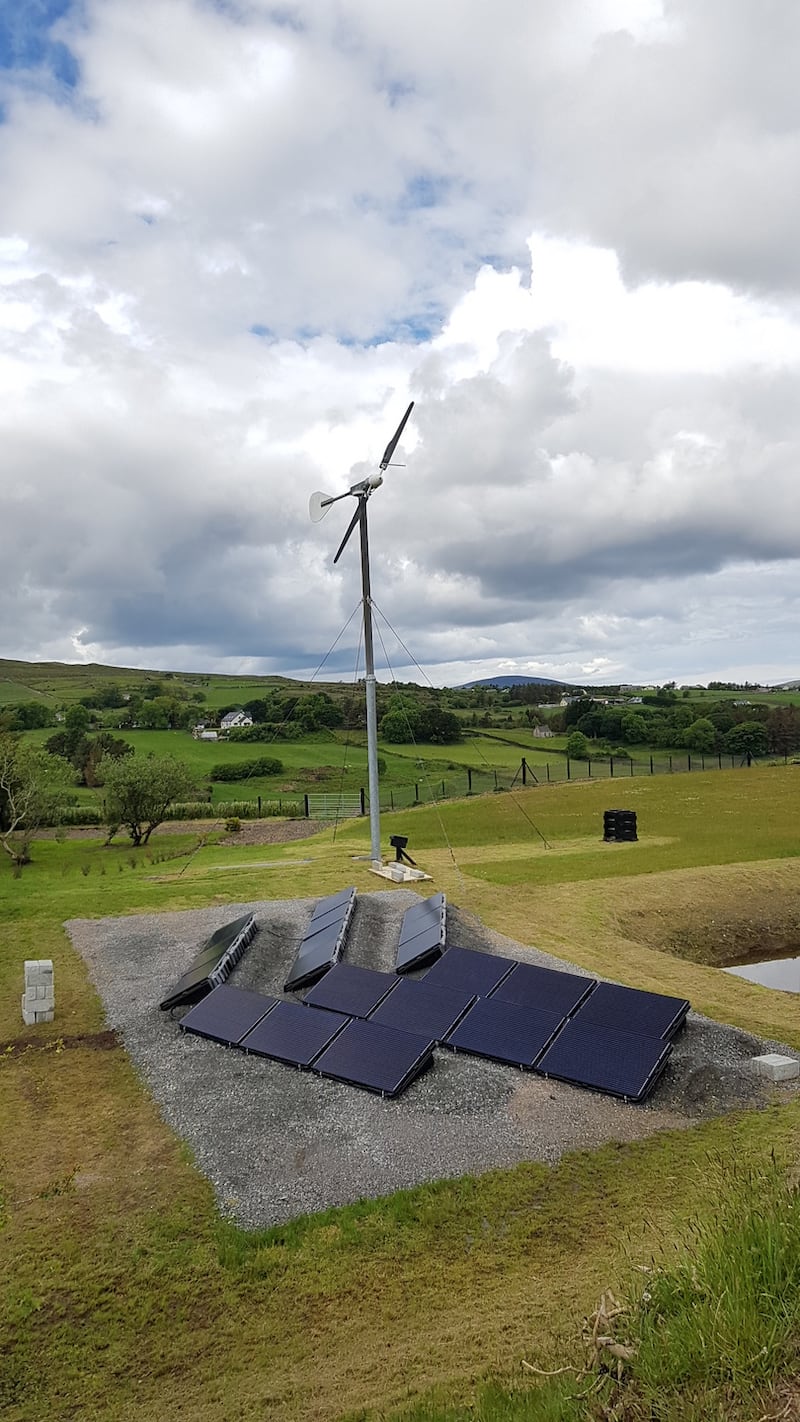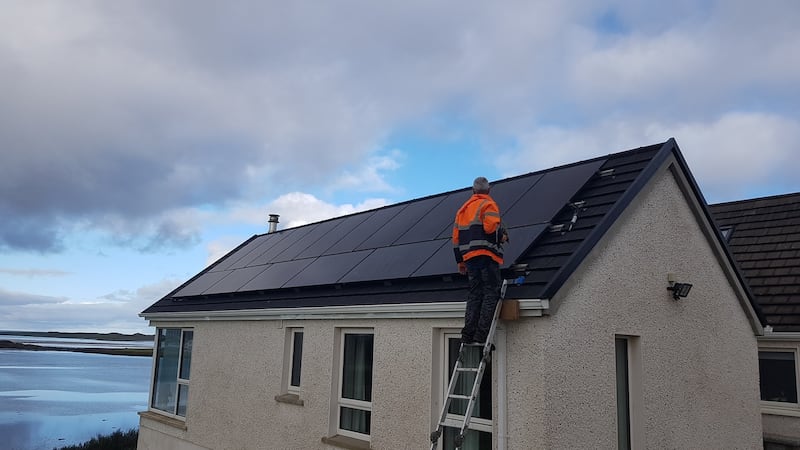The image of Charlie Haughey with his own wind turbine on Inishvickillane in the 1980s was the nearest Ireland got to the secret, self-sufficient bunker of a James Bond villain. It seemed like the stuff of make-believe at the time and yet in the last few years the arrival of cheap solar photo-voltaic (PV) panels allow all of our homes to become independent micro-generation stations, producing electricity for our own needs and potentially profiting from any excess we produce.
I wrote recently about the practicalities of installing 4.2kW (14 PV panels) in my own house. The article explored the costs involved, the potential pay-back time and the questionable practises of some high-profile companies who use persistent doorstep selling and widespread regional advertising to capture large swathes of the market and charge higher prices than many independent installers – basically the dodgy double-glazing salesmen of the PV world.
But, there are wider issues at stake here, such as how micro-generation of electricity locally could change so much about our world. Currently, Ireland has the second most decarbonised electricity in Europe, largely due to the on-shore wind farms constructed over the last decade. Electricity will be roughly 40 per cent decarbonised by the end of 2020, and the aim is to have it 70 per cent decarbonised by 2030. This feat is only achievable if everyone, including homeowners, businesses and community buildings begin generating their own electricity.
"The buzz word is prosumer," says Fergus Sharkey who was general manager of Kingspan ESB before becoming head of public and private sector business with the Sustainable Energy Authority of Ireland (SEAI). "It refers to how the public will both produce and consume energy, becoming active participants in the generation of electricity," he says. The vision is for community energy co-ops, with PV panels on the roofs of schools, businesses and housing estates which are all interconnected through the grid, thus allowing for peer to peer selling locally within the community.
“There’s almost a social movement behind this,” says Sharkey. “People are coming together and meeting in town halls saying they want to decarbonise their town or community, and this is often co-ordinated through us at SEAI.” The whole regulatory and market environment will need to adapt considerably, but the Department of Communications, Climate Action and Environment is working with the ESB and the Commission for Regulation of Utilities to put changes in place.

The first pilot schemes can be seen in the likes of Fuinneamh Oileáin Árann, a sustainable energy co-operative, spearheaded by Aran Islanders which aims to make the islands’ energy independent. “They would like to have a single point of trading with the grid, which could be the cable to the mainland,” says Sharkey. “And outside of that they will manage their own internal flows of electricity - with a scheme where they are paying for power between themselves.”
It does seem to be happening incredibly slowly though.
"The fastest, most cost-effective way to roll out solar PV would be on industrial rooftops," says Quentin Gargan of Solartricity, "but, exporting anything over 50kW introduces huge delays. While this is all held up for up to three years, there are proposals to buy power at a subsidised price from large solar PV parks, with auctions to supply this energy starting early next year. So while industrial solar is tied up in knots with bureaucracy, a network of 25-acre [10 hectares] solar parks will spread across prime cultivation land, and roof-top solar may then be curtailed for capacity reasons."
Many people in the industry believe that the ESB is reluctant to implement new technologies which give power to communities or networks of businesses, but Sharkey maintains that while “they do control who gets to connect to the grid, they also recognise that this is the way society is moving. Communities will invariably become more actively involved in the electricity system, rather than people just paying the ESB for it.”
On the Dingle Peninsula, ESB Networks has set up a type of virtual power plant of multiple domestic and public PV systems and batteries which all communicate between each other, and which are then used to manage the grid.
Both homeowners with PV systems and solar installers talk with messianic fervour about the watershed coming in 2021 when energy suppliers will finally be forced by an EU directive and the government’s Climate Action Plan to buy back surplus energy from people’s homes. From then on your roof, or the solar array in your garden, can actually be accruing profit for you on clear days by sending excess electricity to the grid. Depending on the price that the government and the ESB set for this feed-in tariff, it might significantly speed up the pay-back time on the €5,500 I spent on my 4.2kW system. It’ll also make it easier for communities to invest in renewable electricity projects in their area. The challenge though is to ensure that it’s not just the elite who prosper by creating power generating systems on their roofs, leaving the burden of paying for the national grid on a smaller group of public electricity users with less disposable income, who would then have to pay higher fees.
Rapid change
Barry Sharkey (no relation to Fergus), a solar installation company working in the northwest of Ireland, acknowledges this risk, but says that "with good policy it can be avoided, and producing electricity locally is far better than bringing it the whole way from the largest power station in Ireland, Moneypoint, Co Clare, where it loses 15 per cent power in transmission losses through the cable. It just makes sense for homes to produce their own power and share it between themselves via smart meters. This reduces the load over the entire area. Rather than buying it from ESB at 20 cents per unit, you get it from your neighbour for around 12 cents, and sell it to them for the same price. And your neighbour doesn't even need to be beside you, they can be on the other side of the country, just connected through the meter by an internet portal," he says.
Having consumers actively involved in the grid could also avoid the wastage that now happens when the ESB limits the production of wind energy on stormy nights. "The turbines are producing far more energy than the grid can take at times in winter," says Barry Sharkey, "and so Eirgrid curtails this power, because we don't have adequate storage capacity for it. They could instead incentivise homeowners to use this excess power to charge their batteries and their car or heat their homes by offering significantly reduced electricity on stormy nights."

In Germany and some other European countries, home battery manufactures have reached agreement with electricity authorities to store excess power in homeowners' batteries and to release this when needed. Sonnen batteries are at the forefront of this. Smart energy schemes like this would be a game changer in Ireland, and all that is required is for Eirgrid/ESB Networks to allow manufactures to connect to Ireland's national grid (which all of us own) and to share the data they get from the smart meters that are being installed in our homes.
It seems that change is coming remarkably quickly in how Ireland generates and uses electricity. Barry Sharkey says he witnesses it first-hand with people who install PV systems. “The good ones radically adapt the way they consume energy, keeping a sharp eye on the sun and loading up the washing machine and baking off bread when they have the kilowatts to spare.” They learn to trust the sophisticated control equipment which is set up to first meet the electrical needs of the house, then to charge the battery, then to heat the immersion, and when the water is hot the surplus goes to a panel heater, or to your electric car or back into the grid. “This is the future, there’s no doubt about it.”
Fergus Sharkey of SEAI agrees, but stresses that “really PV should only be considered once you’ve done everything else to reduce the energy use in the building: increasing insulation, installing smart heating controls, using LED lights and switching them off when not needed. Only once you have a building with a high Building Energy Rating that’s using as little energy as possible should you think of offsetting the tiny remaining bit with PV on the electrical side and renewable heat in the form of heat pumps or biomass for the heating.”
The frugality of turning off light switches and waiting for the sun to come out before doing the laundry is far removed from a Bond villain’s bunker, but it seems that this is what a sustainable future of independent, energy-producing homes is all about.










